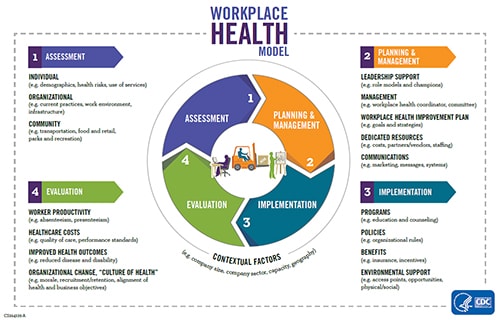Workplace Health Model
The workplace is an important setting for health protection, health promotion and disease prevention programs. On average, Americans working full-time spend more than one-third of their day, five days per week at the workplace.
While employers have a responsibility to provide a safe and hazard-free workplace, they also have abundant opportunities to promote individual health and foster a healthy work environment for more than 159 million workers in the United States (Accessed US Bureau of Labor Statistics April 12, 2016).
The use of effective workplace programs and policies can reduce health risks and improve the quality of life for American workers.
Maintaining a healthier workforce can lower direct costs such as insurance premiums and worker’s compensation claims. It will also positively impact many indirect costs such as absenteeism and worker productivity.1, 2
To improve the health of their employees, businesses can create a wellness culture that is employee-centered; provides supportive environments where safety is ensured and health can emerge; and provides access and opportunities for their employers to engage in a variety of workplace health programs.
What are workplace health programs
Workplace health programs refer to a coordinated and comprehensive set of strategies which include programs, policies, benefits, environmental supports, and links to the surrounding community designed to meet the health and safety needs of all employees.
Examples of workplace health program components and strategies include:
- Health education classes
- Access to local fitness facilities
- Company policies that promote healthy behaviors such as a tobacco-free campus policy
- Employee health insurance coverage for appropriate preventive screenings
- A healthy work environment created through actions such as making healthy foods available and accessible through vending machines or cafeterias
- A work environment free of recognized health and safety threats with a means to identify and address new problems as they arise
Impact of workplace health programs
Workplace health programs can lead to change at both the individual (i.e., employee) and the organization levels.
For individuals, workplace health programs have the potential to impact an employee’s health, such as their health behaviors; health risks for disease; and current health status.
For organizations, workplace health programs have the potential to impact areas such as health care costs, absenteeism, productivity, recruitment/retention, culture and employee morale.
Employers, workers, their families and communities all benefit from the prevention of disease and injury and from sustained health.
Building a workplace health program should involve a coordinated, systematic and comprehensive approach

A coordinated approach to workplace health promotion results in a planned, organized, and comprehensive set of programs, policies, benefits, and environmental supports designed to meet the health and safety needs of all employees. A comprehensive approach looks to put interventions in place that address multiple risk factors and health conditions concurrently and recognizes that the interventions and strategies chosen influence multiple levels of the organization including the individual employee and the organization as a whole.
Workplace health promotion programs are more likely to be successful if occupational safety and health is considered in their design and execution, In fact, a growing body of evidence indicates that workplace-based interventions that take coordinated, planned, or integrated approaches to reducing health threats to workers both in and out of work are more effective than traditional isolated programs. Integrating or coordinating occupational safety and health with health promotion may increase program participation and effectiveness and may also benefit the broader context of work organization and environment.1-4
The systematic process of building a workplace health promotion program emphasizes four main steps:
1. Sorensen G, Stoddard A, LaMontagne A, Emmons K, Hunt M, Youngstrom R, et al. A comprehensive worksite cancer prevention intervention: behavior change results from a randomized controlled trial in manufacturing worksites (United States). Cancer Causes Control.2002;13:493–502.
2. Sorensen G, Barbeau EM, Stoddard AM, Hunt MK, Kaphingst K, Wallace L. Promoting behavior change among working-class, multi-ethnic workers: results of the Healthy Directions — Small Business Study. Am J Pub Health. 2005;95(8):1389–1395.
3. Hunt MK, Lederman R, Stoddard AM, LaMontagne AD, McLellan D, Combe C, et al. Process evaluation of an integrated health promotion/occupational health model in Well-Works-2. Health Education & Behavior.2005;32(1):10–26.
4. Meas S, Verhoeven C, Kittel F, Scholten H. Effects of a Dutch worksite wellness-health program: the Brabantia project. Am J Pub Health.1998;88:1037–1041.